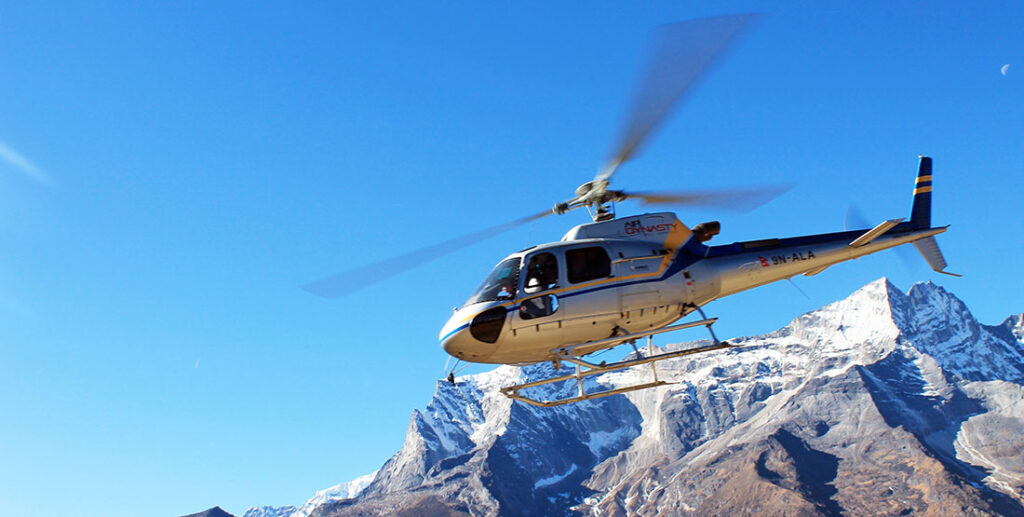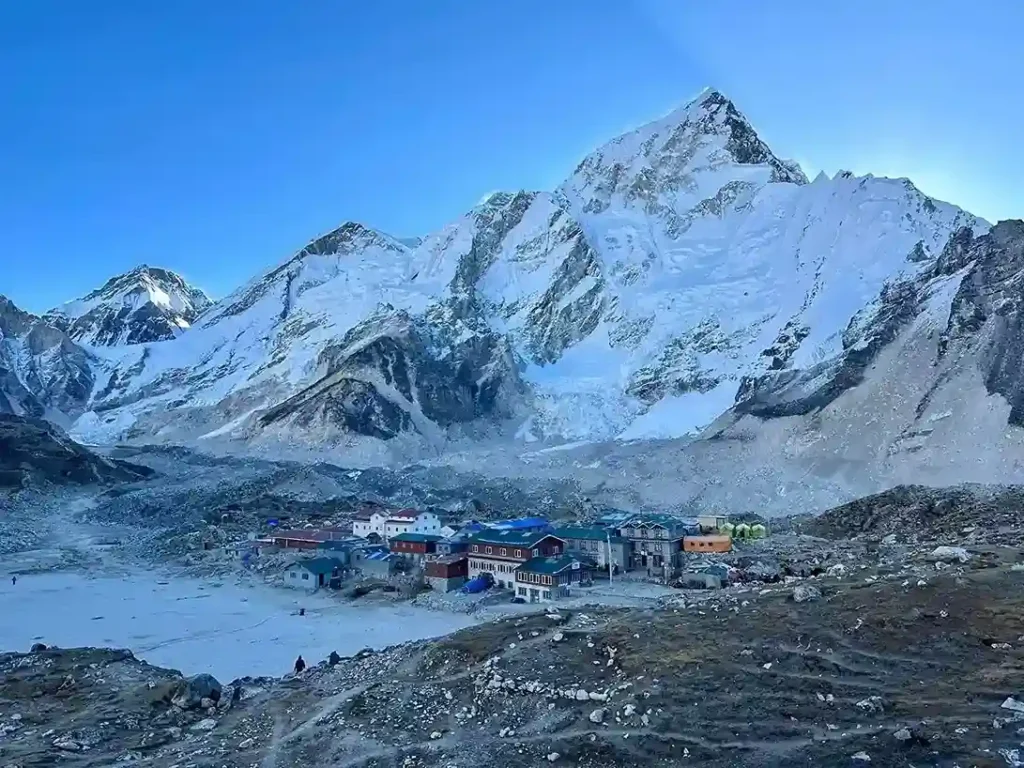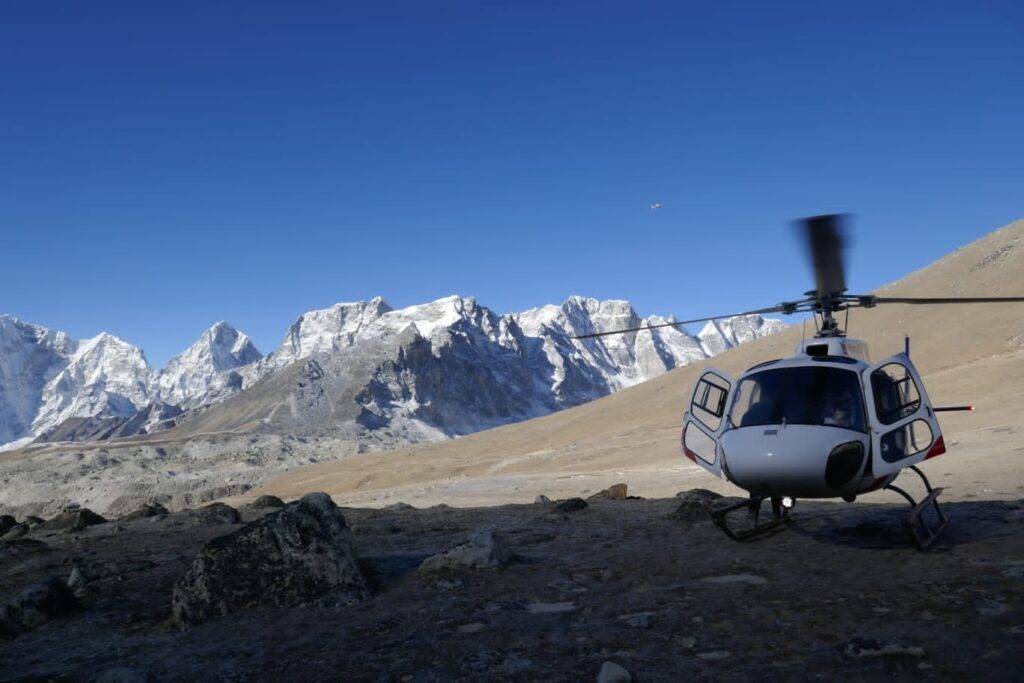The highest peak of the Earth, mount Everest, with an altitude of 8,848.86m (29,031.7 feet), is an emblem of people’s aspiration and determination. Sitting on the border between Nepal and Tibet in the Mahalangur Himal sub-range of the Great Himalayas. It has been a favorite of climbers and tourists for years. Mountaineering, in general, is a hazardous and complex task throughout, with factors such as high altitude, elaborate climatic conditions, and the rugged terrains of the mountains making it very risky to climb Everest in particular.
Although the climber needs so much energy and good health to reach the pinnacle, there is no doubt that hikers ask themselves: Can a helicopter take them to the summit of such a famous mountain? Helicopters are still used to reach the highest point of Mount Everest, although this type of flight operation cannot be considered normal at all.
Helicopters are generally developed to work at lower aircraft to create adequate density for a stable flight. There is thin air at high altitudes, which means that the helicopter blades cannot develop optimal lift. This means that the peak of Everest falls at a high altitude, or the “death zone,” where the altitude is above 8000m, and in such environmental conditions, both human beings and machines struggle to survive.

To achieve control, stability, and power, helicopters must fight thin air; not all copters can do such a feat. In September 2005, an Airbus AS350 B3 helicopter flown by French pilot Didier Delsalle successfully landed on the summit; this is currently the only known helicopter landing on the mountain.
The AS350 B3 is an elliptical high-altitude helicopter used for Nose for operations under challenging terrains; however, the flight was short and carefully planned to avoid danger. The conditions for such a landing must be near perfect: no clouds, no high wind speed, and no loads. The Helicopter is often light, so it might have little fuel and equipment. Reaching the top is a hazardous operation despite these favorable conditions, and helicopter rescue practice at such an altitude remains extraordinary.
The following risks are involved when one decides to fly a helicopter to the top of Mount Everest. First, because of the high altitude, pilots experience all the risks that mountain climbers do, which include altitude sickness and hypoxia. Also, the Helicopter’s engine needs to work harder because of the low-pressure air, which often causes mechanical breakdown of the Helicopter or loss of control.
The weather in Everest is best characterized by high-speed winds that make the air at the summit highly turbulent and, hence, not very conducive for flight maneuvers. In addition, because the surface of the moon is rocky and has ice on it, there are no proper places to land.
By and large, helicopters for rescue are generally done at lower altitudes, like from the Base Camp at 5,364 meters or higher camp up to 6,500 meters, where the chopper can hover and operate. Although rescue by Helicopter is usually possible at these higher relative levels, the procedure is hazardous and impracticable. Those climbers who need assistance while approaching the apex need help from fellow climbers or Sherpas rather than emergency air evacuation. Finally, helicopters may occasionally reach the top of Everest, but it is still a precarious and ineffaceable mode. The main difficulties that result in high risks of helicopters’ operation at such height are the following:
Can A Helicopter Fly To The Top Of Mount Everest: Updated 2024
Air Pressure and Density:
Rotary wing aircraft are supported by lift, which originates from the rotation of the blades and is applied against the surrounding air pressure. These lifts are required if the Helicopter has to be maintained in the air. However, at higher altitudes, for instance, Mount Everest, which is 8,848.86 meters/ 29,031.7 feet, the air concentration could be better in this case, a lot less compared to the standard.
With less air density, the rotor blades find themselves in an environment where they have to slog through much less air to lift; it could be more practical. In the typical operational environment, helicopter engines must operate optimally up to around 7000 meters (23000 feet). Beyond this point, there is very little oxygen to carry out combustion in the rotors, which, in turn, makes the Helicopter unstable.
To get the same amount of air at sea level and get the same power on demand, the engine has to work much harder, but at the same time, with available oxygen and lower air pressure, the engine loses its power.
This makes it increasingly challenging to maintain steady flight conditions and control. Incidentally, the current model AS350 B3, which Didier Delsalle famously piloted to land on Mount Everest’s surface in 2005, also utilizes higher powered engines and lighter built to suit these conditions.
Nonetheless, even these helicopters have minimal operational capabilities. To land successfully at such altitudes, the Helicopter has to be reloaded and flown only during nearly perfect meteorological conditions, and then the duration of the flight has to be kept as short as possible.
Oxygen Levels:
Another critical problem is the lack of oxygen at Everest’s mountain. It mainly characterizes the area as having 33 percent of sea-level oxygen concentration. Helicopter engines, particularly turbine engines, require accurate conditions for the elements of fuel and oxygen.
The engine cannot deliver the required power needed to produce lift without the necessary amount of oxygen in the air. However, for the pilot, the absence of oxygen is just a crucial issue. That means that their cognitive and physical actions are impaired due to hypoxia – a condition provoked by the lack of oxygen.
Alternatively, pilots use supplemental oxygen that prevents them from avoiding disorientation or other impairments essential for flying in such situations. In conclusion, Mount Everest’s low pressure and thin air, combined with less available oxygen, means attempting to fly the Helicopter to the top of the mountain is extremely dangerous.
Although it has been successfully implemented in the past under emergency conditions, it is too risky and too costly in terms of workforce to employ routinely or in rescue missions.
Harsh Weather problems
Adverse weather is another significant challenge for helicopters making a Siyah or flying to the highest point on Mount Everest. The above revelations indicate that climbing the mountain is occasioned by high altitude, which is associated with erratic and especially harsh and volatile climatic conditions. Such circumstances mean that flying helicopters and their pilots near the upper part of the mountain would be complicated.
Wind Turbulence:
This is specifically attributed to the fact that Mount Everest is well-known globally for its high winds; the higher the altitude, the stronger the wind at the peak of Mount Everest. Straight across the summit are daily gusts and turbulence that can bring the jet stream with wind exceeding 160 km/h (100 mph).
These solid and gusting winds make it hard for helicopters to control the movement of the aircraft; slight variations in wind velocity and direction can throw the machine off balance, mainly when operating at the top of the mountain.
Sudden Storms:
It is also essential to note that the climate on those latitudes is unstable and may be tweaked at any enabler. Conditions vary from clear to sudden snow hurricanes, storms, or whiteouts where vision is almost nonexistent. This lack of visibility makes navigation clumsy because pilots cannot see their area, environment, or safe altitude.
Moreover, force majeure factors such as storm churn snow and ice, causing them to pile up on the sides of the blades, affecting the amount of lift the Helicopter wants to generate and increasing the chances of mechanical failure.
Low Temperatures:
This is due to extremely low summit temperatures that range between -30 0C (-22 0F). Low temperatures can pose problems with different mechanisms of helicopter helicopters; for instance, there can be engine failures and issues with hydraulics.
Indeed, temperatures this low can also have detrimental effects on the equipment – particularly the fuel lines freezing or the Helicopter becoming less responsive to being flown, possibly being unable to maintain altitude or maneuver correctly in response to weather conditions.
Near the top of Everest, there are very short windows of time when the weather will permit any form of aviation. The mountain’s extreme altitude is characterized by unpredictable and severe weather, which can change rapidly and without warning. These conditions create a dangerous environment for helicopters and pilots, making flights near the summit highly risky.
Limited Weather Windows:
Due to these harsh conditions, there are only very brief periods when the weather is calm enough for air travel near Everest’s peak. These rare and unpredictable windows make planning or executing helicopter missions difficult. Even during these brief periods, conditions can still be marginal, forcing pilots to take considerable risks.
Difficult terrain
Air pressure and oxygen levels have already been discussed while flying a helicopter to Mount Everest. However, the terrain is also an issue. Again, the surface of Everest is precipiced with diverse sharp cliffs and unstable ice flow, making it difficult for the Helicopter to identify a smooth landing zone.
However, if a helicopter manages to reach the peak, there will be little flat or stable surface to negotiate to avoid crashes. However, the fluctuating climate on Mount Everest makes the task more difficult. The surrounding terrain causes solid winds and leads to turbulent air conditions, which is dangerous for helicopters attempting to fly along the mountain’s frequently narrow ridges and slopes.
When coupled with high altitude, these unpredictable winds make flying the Helicopter harder, especially when required to hover adjacent to geographically varied terrains. Also, since the summit area may be covered with snow or ice. The pilot cannot determine whether it is safe to attempt a landing due to poor visibility because of blindness from whiteout conditions. This unforgiving surface environment remains a threat despite helicopters being built for high altitudes.
Need advanced Helicopter and pilot.
Due to many environmental difficulties, operating a helicopter to the higher part of Mount Everest requires special helicopters and, most importantly, pilots with immense experience in flying such machines. While climbing, standard helicopters cannot operate at that high altitude or under challenging conditions near the top of Mount Everest.
In essence, only ‘power’ helicopters that have been built explicitly for high-altitude missions can fly to such heights, and any other LAAH must have these integral features, not forgetting that such models as the one used in the movie include the ‘Eurocopter AS350 B3’. Solid engines power these helicopters, are very lightweight, like those used in fighter planes, and have specially designed rotors to lift the craft at such high altitudes. However, the pilot has an essential role even in the enhanced Helicopter.
Those who try to perform such a stoke must have extra knowledge of flying at high altitudes and be endowed with deep experience in handling various conditions such as wind, turbulence, and other characteristics of thin air. Apart from piloting abilities, the participants need to have strong bodies and minds to work under high altitude conditions where hypoxia and lack of oxygen can negatively impact decision-making and physical response times.
Oxygen is required for flight at such heights, but the pressures that a pilot has to cope with a great heights are still very severe.
Can you take a helicopter to the top of Mount Everest?
Technically, it is possible, but the fat chance of getting a chopper on top of Mount Everest is nearly an impossibility. Besides the requirement for helicopter type and pilot experience, the threats are from the hazardous physical working environment and restrictions on operation.
The weather at this summit is characterized by drastic changes and storms and winds, especially for flying, which are unpredictable. These weather conditions can worsen right from the start, so there is a need to be very careful when undertaking the flight. Moreover, the irregular and steep surface of the locality near the peak again presents great danger even for the most skilled pilots: there is no place on the slope to land.
Besides the fact that cold labor can offset the mechanical systems and the Helicopter’s performance, cold labor also reduces the fuel throughput rate. Hence, although a helicopter can be flown to the pinnacle of Everest, flying turns out to be an environmental and operation risk factor that is unsuitable for regular or rescue flights.
Landing on Mt Everest
Landing at Mount Everest is quite an achievement, but it is fraught with great difficulty and perils. The Earth’s rooftop, or Mount Everest, reaching over 8,848.86 meters (29,031. 7 feet), is the most challenging condition for any airborne vehicle, including helicopters.

Daniel’s landing and the crash in the miniseries were both fictional; the only substantiated helicopter landing was made by Didier Delsalle in 2005 using an altered Eurocopter AS350 B3.
The main problem due to the high altitude is lesser oxygen density, which reduces lift and makes it challenging to maintain a stable flight; the optimum for most standard helicopters is up to 6,000 to 7,000m. Furthermore, the optimum weather condition can abruptly change, making operations extremely hard given the existence of gale-force winds, blizzards, and low-ranking temperatures at the peak of Everest.
Some factors involved in such higher altitude landings require special helicopters that are highly performing machines, usually with more powerful engines and lighter to offset the compelling power of lift.
The summit is not flat, making it hard on the physical structure necessary for landing and takeoff, including rocks and ice. However, most helicopter rescues are done at Base Camp or Camp II because helicopter landing and takeoff conditions are better at these altitudes.
In general, landing on Mount Everest is possible only with sufficient equipment development, the pilot’s experience, and, finally, the weather conditions, so such an event in aviation is considered unique.
Highest landing point in Everest
The last stop, the topmost level of Mount Everest, is 8,848.86 meters or 29,031.7 feet of the world’s height. The record was set by the pilot Didier Delsalle from France, who landed his Eurocopter AS350 B3 helicopter on the ice on May 14, 2005.
This flight is still recorded in aviation history as the ultimate feat, having ever been made at the height of a helicopter. There may have been other flights in the same region, but no other pilots have ever landed their Helicopter on the summit as Delsalle did.
How high can a helicopter fly in Everest?
Hence, the maximum altitudinal capacity of a helicopter that operates in the Everest region varies depending on the model and design of the aircraft for the alpine environment. Standard helicopters are usually capable of high performance with altitudes up to 7000m (23000 feet). However, to significantly higher, some helicopters, such as the Eurocopter AS350 B3, are designed for carrying out missions at higher altitudes.
Pilot Didier Delsalle landed the Eurocopter AS350 B3 on the top of Mount Everest at 5,884 meters (18,208 feet) in 2005 to prove that some models of helicopters can indeed fly to the top under the right conditions.
However, this is not the normative situation; it is the reverse. The majority of helicopters can barely operate at altitudes of 6,000 to 7,000 meters because of the high altitude and its accompanying effects, such as lift and engine characteristics.
From an experience perspective, most helicopters that fly in the Everest area are mainly used for flights below Base Camp, although Base Camp is at 5,364 meters or 17,598 feet.
Have helicopters ever gone beyond Mount Everest?
Regarding operational flights, helicopters have yet to take flight beyond Mount Everest, which stands 8,848.86 meters or 29,031.7 feet tall. The record of helicopter height is recognized up to 2005 by pilot Didier Delsalle, who landed his Eurocopter 350 B3 on the summit of Mount Everest. This continues to be the ultimate in high-altitude helicopter capability. I can tell you it is not easy to fly higher than Everest.
Helicopter ops, or the thin air, seriously affects the lift capability, significantly affecting the center of gravity and, consequently, the stability of the aircraft. Every engine has its preferred blend of oxygen and fuel, and when the oxygen levels are low, the Helicopter’s engine will struggle. These factors are a blend that restrains most helicopters to a much lower elevation than Everest’s summit.
While possibly accompanying helicopters could be designed to fly at much higher altitudes, there needs to be a more practical reason for such flights on Everest. Due to the high danger levels, harsh weather conditions, and lack of urgency to fly beyond Mount Everest, it is relatively unusual and unknown. There is a record that the highest altitude attained by a helicopter is at Everest, and extensive operations have yet to be performed at higher slopes.
Helicopter rescue in Everest
Mountain rescue operations, especially by helicopters, are important but are associated with many challenges. One example is helicopter rescue on Mount Everest. Others are altitude restraints, where none of the contemporary helicopters can operate effectively at an altitude higher than 6,000-7,000 meters due to low temperatures and pressure and poor weather, which makes flying very dangerous. Features such as steep and icy grounds reduce opportunities for landing, and the helicopters bank during rescues.

It also helps decrease the lift, so pilots are forced to use additional oxygen in airplanes. Still, a pilot, Maurizio Folini, has made classic rescues at 7,800 meters; these confirm the effectiveness of specialized helicopters and equally competent pilots. In most rescue operations, however, the weaknesses come to the fore at relatively lower altitudes like the Base Camp or Camp II. These crashes have kept the rescues, though advanced techniques in helicopters and pilot training have depicted progress over the years.
Send an Enquiry
Error: Contact form not found.
© 2025 - Himalayan Trekking and Tours (P) Ltd. All Rights Reserved.

